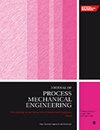Experimental and numerical investigations of aerospace alloys: Effect of machining
IF 2.2
4区 工程技术
Q2 ENGINEERING, MECHANICAL
Proceedings of the Institution of Mechanical Engineers, Part E: Journal of Process Mechanical Engineering
Pub Date : 2024-08-30
DOI:10.1177/09544089241278080
引用次数: 0
Abstract
Aerospace materials like Ti6Al4V and Inconel 718 have exceptional abilities such as high strength, good corrosion resistance, and low specific weight. These properties make them difficult to machine due to rapid tool wear, high cutting forces, and heat generation. Microstructural characterization has been performed for these alloys to identify the phases and precipitates. With the help of machining simulations, experimental trial and error can be avoided. Numerical simulations predict the behavior of materials like Ti6Al4V and Inconel 718 under various machining conditions. They provide insights into stress distribution, temperature rise, and chip formation, which are crucial for understanding how these materials respond to machining. By simulating different cutting parameters (e.g. speed, feed rate, and depth of cut), optimal conditions can be identified to minimize tool wear, improve surface finish, and reduce machining time. Achieving a high-quality surface finish is challenging with these materials. Simulations can predict the impact of different machining parameters on surface integrity, allowing for adjustments before actual machining. Three-dimensional finite element-based machining simulations are performed using the ABAQUS. The current work includes Johnson-Cook damage model parameters included in the simulation with the aid of the program ABAQUS/EXPLICIT. The numerous sets of tests carried out are also stated, along with the workpiece and tool-optimized geometry. The outcomes for cutting forces about time for Ti6Al4V and Inconel 718 are retrieved. The arbitrary Lagrangian–Eulerian approach has been used for these simulations. A coupled thermo-mechanical study is conducted on different sets of materials under various machining conditions. In addition, ultrasonic-assisted cutting on aerospace materials is also being studied, along with a comparison of the cutting forces used by conventional cutting. On the surfaces of aerospace materials that have been machined, temperature and von Mises stress distribution are discussed for both ultrasonic-assisted cutting and conventional cutting. The reaction forces generated for titanium alloy Ti6Al4V under conventional cutting are cutting force (RF3), and the thrust force (RF2) were 56 and 14 N, respectively. For the Inconel 718, the cutting and thrust forces are 75 and 27 N, respectively. The maximum temperature and stress under conventional cutting attained in Ti6Al4V are 670 K and 1.74 GPa, respectively. For the Inconel 718, the maximum temperature and stress under conventional cutting are 596 K and 1.65 GPa. There is a reduction in the forces, maximum temperature, and stress for the ultrasonic-assisted cutting.航空航天合金的实验和数值研究:机加工的影响
航空航天材料(如 Ti6Al4V 和 Inconel 718)具有高强度、良好的耐腐蚀性和低比重等优异性能。这些特性使它们难以加工,因为刀具磨损快、切削力大、发热量高。已对这些合金进行了微结构表征,以确定相和析出物。在加工模拟的帮助下,可以避免实验试验和错误。数值模拟可预测 Ti6Al4V 和 Inconel 718 等材料在各种加工条件下的行为。它们提供了对应力分布、温升和切屑形成的深入了解,这对理解这些材料如何应对加工至关重要。通过模拟不同的切削参数(如速度、进给量和切削深度),可以确定最佳条件,从而最大限度地减少刀具磨损、提高表面光洁度并缩短加工时间。对于这些材料来说,实现高质量的表面光洁度是一项挑战。模拟可以预测不同加工参数对表面完整性的影响,以便在实际加工前进行调整。我们使用 ABAQUS 进行了基于有限元的三维加工模拟。目前的工作包括借助 ABAQUS/EXPLICIT 程序在模拟中加入约翰逊-库克损伤模型参数。此外,还说明了所进行的多组测试,以及工件和刀具的优化几何形状。对 Ti6Al4V 和 Inconel 718 的切削力随时间变化的结果进行了检索。这些模拟采用了任意的拉格朗日-欧勒方法。对不同加工条件下的不同材料进行了热机械耦合研究。此外,还对航空航天材料的超声波辅助切割进行了研究,并对传统切割所使用的切割力进行了比较。在已加工的航空航天材料表面上,讨论了超声波辅助切割和传统切割的温度和 von Mises 应力分布。钛合金 Ti6Al4V 在传统切削下产生的反作用力为切削力(RF3)和推力(RF2),分别为 56 N 和 14 N。Inconel 718 的切削力和推力分别为 75 N 和 27 N。Ti6Al4V 在传统切削条件下达到的最高温度和应力分别为 670 K 和 1.74 GPa。对于铬镍铁合金 718,常规切割下的最高温度和应力分别为 596 K 和 1.65 GPa。超声波辅助切割的作用力、最高温度和应力都有所降低。
本文章由计算机程序翻译,如有差异,请以英文原文为准。
求助全文
约1分钟内获得全文
求助全文
来源期刊
CiteScore
3.80
自引率
16.70%
发文量
370
审稿时长
6 months
期刊介绍:
The Journal of Process Mechanical Engineering publishes high-quality, peer-reviewed papers covering a broad area of mechanical engineering activities associated with the design and operation of process equipment.

 求助内容:
求助内容: 应助结果提醒方式:
应助结果提醒方式:


